 |
African Bull Frog Care Sheet
Common name: African Bull Frog, Pyxie Frog, African Burrowing Frog, South African Pyxie.
Scientific name: Pyxicephalus adspersus
There is a Dwarf African Bull Frog, which is less commonly kept in captivity, but here is the scientific name for the Dwarf species: Pyxicephalus edulis.
Description
Description: African Bull Frogs are large bodied frogs with broad ridged backs and powerful hind legs. They tend to be olive green in colour, but there are differences between the sexes in regards to the colour of their underbellies. Males usually have a yellow or orange belly and throat, whilst females are more creamy beige underneath. Juveniles may have dorsal stripes down their backs and females are more likely to keep this stripe into adulthood than males.
Size: Males can grow up to about 20-25cm (8-10 inches), whilst females are smaller and can reach about 11- 15cm (4-6 inches).
Life span: African Bull Frogs can live up to 20 years generally, but life spans of up to 40 years are not unheard of.
Origin: African Bull Frogs are native to the Sub-Saharan areas of South Africa.
Habitat: African Bull Frogs spend a lot of time buried just below the surface of the ground. They stay there camouflaged amongst the undergrowth and wait for prey to come to them. They are not very active in the dry season and can grow a cocoon of skin around themselves to help keep moisture in whilst they hibernate. This is called Estivation (see topic below). They usually awaken at the on-set of the rainy season and this is the time they will breed and be most active.
Interesting facts about the African Bull Frog.
The African Bull Frog’s predators include large birds, monitor lizards, various mammals and man! The African Bull Frog is considered a delicacy in some areas of the world.
Things to consider before purchasing your first Amphibian
• Who will look after your new pet if you are away?
• Can you obtain its food easily from your local pet shop?
• Would you be comfortable feeding live insects as food?
• Are you comfortable having live food in the house to feed your pet?
• Is the rest of the family happy to live with an amphibian?
Captive Care
Temperament
African Bull Frogs are great first amphibians for beginners, because they are relatively easy to care for. They are also a very hardy species, so it is unlikely that your pet will become ill.
The only thing to worry about with African Bull Frogs is their predatory tendencies. They will generally eat anything that moves, including other African Bull Frogs, so should be kept singularly.
They can be aggressive, so be careful where you put your fingers. If they mistake your hand for food they have a very powerful jaw and grip, so it can be quite painful to experience.
If you are bitten by your African Bull Frog it is unadvisable to pull your hand away from the bite as you can damage to your frog’s jaw that way. Holding the frog under cold running water should encourage your African Bull Frog to let go and a simple antiseptic should be applied to the bitten area.
Feeding
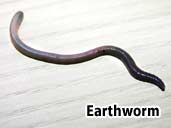 |
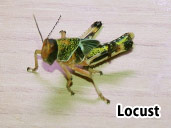 |
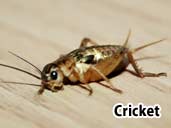 |
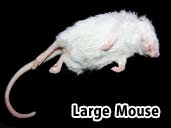 |
Juvenile African Bull Frogs should be fed daily, with calcium and vitamin D3 supplements added to the meal 4 to 5 times a week. Juveniles will eat appropriately sized earthworms, cockroaches, pinkie mice, crickets and waxworms.
Adult African Bull frogs can handle larger prey items such as earthworms, locusts, crickets, cockroaches, mealworms, moths, beetles and waxworms. Rodents can also be given to your adult African Bull Frogs, but this should be a treat item as regular feeding of a rodent as a staple food item can lead to obesity. Large mice are suitably sized for females, although a fully grown male may have no difficulty eating a small rat. Adults should be given supplements every other feed. Live feeding rodents is not advised as they have sharp teeth and can bite and injure your frog. Frozen thawed mice will readily be taken by most adult African Bull Frogs.
Using feeding tongs or forceps is advised when feeding your African Bull Frog, as they can jump quite high and easily mistake your fingers for food.
Housing
African Bull Frogs are fairly inactive so do not need really large enclosures. They will grow quite big though, so adequate space should be provided to meet your African Bull Frogs needs. An adult male would need a suitable enclosure at approximately 3ft long and at least 1ft wide or a 20 gallon aquarium.
A glass tank, plastic RUB (really useful box) or a terrarium make good homes for African Bull Frogs. They prefer a woodland type set up within their housing.
Your terrarium should contain:
Substrate
Deep Coco husk, Eco-earth and fertilizer-free soil are good substrates to use, as African Bull Frogs like to burrow and spend much of their time just beneath the surface of the substrate.
A simpler, but less attractive substrate is paper towels. These are cheap, fit for purpose and easy to clean if they become soiled.
Live moss, which is rooted into the substrate, can be used in your terrarium, but loose sphagnum moss should be avoided, so that there is no risk of ingestion during feeding.
Water
All amphibians need fresh water daily. A large, shallow water bowl should be provided containing de-chlorinated or bottled spring water. Tap water may be used as long as it has either been treated with a de-chlorinating solution or been left to stand uncovered for over 24 hours, so that the chlorine can evaporate.
If you would like a more elaborate set up then a 50/50 split to the tank is also an option. Dedicate half the terrarium to terrestrial burrowing space and the other half to a water area. A filter may be added to help keep the water clean and it is advisable to have a ramp between the two areas to aid your frog when leaving the water.
The depth of the water should be no higher than the height of your African Bull Frogs mouth when at rest.
African Bull Frogs like most amphibians will soak up water through their skin and since their water bowl is used as the main place to defecate it is important that it is cleaned daily.
Humidity
African Bull Frogs require high humidity within their terrarium. Humidity of above 80 is recommended, so having a hydrometer within the tank is useful to ensure that humidity stays at the correct level.
Lightly misting the terrarium a few times daily with de-chlorinated water in a spray bottle should suffice to keep humidity at the right level for your African Bull Frog, but additional humidity can be encouraged by place the water bowl nearer the heat source.
Ensure that between mistings the substrate remains damp, but not water logged.
A place for your African Bull Frog to hide
All amphibians require somewhere to hide and may become stressed if this is not provided. African Bull Frogs prefer to hide under the substrate and will bury themselves to stay hidden, but inexpensive plant pots, aquarium ornaments, logs, branches and stones can also be added to give your African Bull Frog greater opportunities to hide.
Live plants can be used in your aquarium, but African Bull Frogs are known to burrow, so expect them to be easily uprooted. Plastic plants may be a better alternative, as they can withstand the trauma of a burrowing frog and also be cleaned and disinfected regularly.
Heat
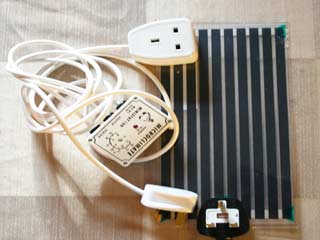 The ideal temperature for your African Bull Frog is a temperature of around 25-28°C (77- 82°F), with a slight drop at night time.
The ideal temperature for your African Bull Frog is a temperature of around 25-28°C (77- 82°F), with a slight drop at night time.
Heat should be provided using a heat mat on the side of the tank with an appropriate thermostat. Heat mats should only cover between a third and a half of the wall space to allow your African Bull Frog to thermo-regulate. The mat should be along the wall space because African Bull Frogs are large bodied frogs that like to burrow, so the risk of burning your frog with a under tank heat mat are higher than with other types of amphibian.
Never use heat lamps or basking lamps for amphibians, as these can cause your African Bull Frog to dehydrate.
It's useful to have a small thermometer on either end of the terrarium to check the temperature.
Lighting
African Bull Frog should be kept out of direct sunlight to ensure that the light from the sun does not generate too much heat within the terrarium.
African Bull Frogs do not need the addition of UV lighting if they have enough vitamins and variation in their diet. Although you may find the live plants in your terrarium will die without any light. A fluorescent UVB tube is ideal as it won’t give out any heat and will help the plants thrive. You should place the light at one side of the terrarium creating a light gradient so your toads can find a darker place out of the light if preferred. Ideally you should cycle the lighting to mimic the frogs natural habitat by having a 12/12 system - 12 hours of light and 12 of dark.
Cleaning
Daily spot cleaning is required and any defecation should be removed if possible to do so. You will also need the clean the water bowl daily.
Your entire terrarium should be completely cleaned out on a 3-4 week basis. Your African Bull Frog should be moved to a temporary tank whilst being cleaned.
All substrate and décor should be removed and refreshed. Use an amphibian safe disinfectant to clean the terrarium to prevent the build up of bacteria, but always ensure that all chemicals are thoroughly rinsed away, so that there is no chance that they will harm your African Bull Frog.
Handling
African Bull Frogs are one of the few amphibians that can be handled, but it should not be done too regularly or for prolonged amounts of time. It is advisable to wash your hands both before and after handling. This is because African Bull Frogs, like all amphibians, have delicate, absorbent skin and the oils and salts on our hands can cause them harm. Handling your frog with clean, wet hands makes it more unlikely that any substances on our skin will hurt your frog. Alternatively, Latex or surgical gloves can be worn during handling.
African Bull Frogs can give a nasty bite, so be extra careful when placing your hands and fingers near your frog’s mouth during handling.
Sloughing
African Bull Frogs shed their skin at regular intervals as they grow. The old skin is pushed off with the hind legs and the skin peels off from the back end. The skin should come off in one piece and is normally eaten by the frog. The skin is pushed forwards using its legs towards the mouth.
Estivation
Estivation is the term given to the period of Hibernation that wild African Bull Frogs usually go into during the dryer months. They create a cocoon from old skin that helps to seal in moisture whilst the frog buries itself in the ground to wait for the rainy season to come.
Your African Bull Frog is unlikely to go into estivation, if temperatures and humidity are controlled successfully, but if you experience a drop in temperatures or humidity within your terrarium, your African Bull Frog may start to estivate.
You should not feed or disturb your African Bull Frog during estivation, but fresh de-chlorinated water should always be available.
Bring your African Bull Frog out of Estivation by slowly raising the temperatures or creating higher humidity over a few days. This should awaken your African Bull Frog and bring them back to normal activity.
Sexing
The easiest way to determine the sex of your African Bull Frog is by listening, as males will call during the mating season. They will also develop broader heads than the female, have yellow or orange chests and grow to a larger size.
Females are usually a lot smaller than the males, tend to have beigey cream coloured undersides and can retain a dorsal stripe as they grow.
Breeding
The breeding season for wild African Bull Frogs is brought about by the on-set of heavy rains. Temporary pools are created by the wet weather, which are quickly taken over by the males, who will call and fight to attract the best mate. During amplexus up to 4,000 eggs can be spawned, which are then guarded fiercely by the males until they hatch.
African Bull Frogs in captivity are unlikely to breed in a small terrarium, so if you are planning to breed your frogs you will need a large pool or pond within a secure green house. Some Breeders have also found children’s paddling pools useful in providing room for your African Bull Frogs to breed.
Once spawned, eggs will hatch within 2 days and metamorphosis into froglets takes approximately 2 to 4 weeks.
Other questions about the African Bull Frog
If you have any other questions why not join The Amphibian Forum and ask one of the many experienced keepers. The reason this website was set up was so people in the amphibian keeping hobby could share their experiences with others.

